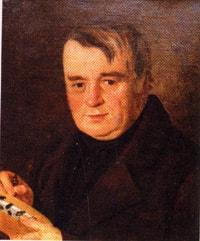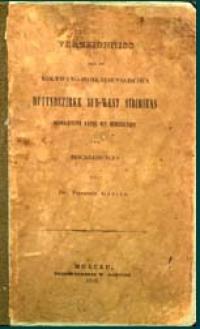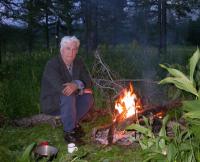Вы здесь
Friedrich Gebler on Altai.



Walk to the Gebler Glacier near Belukha.
“Our venerable companion, our doctor Gebler, took upon himself barometric observations, in which he gained great experience, wandering every year in the Altai”
G. Schurovsky, organizer of the expedition F. Gebler.
Trip from Zyryanovsk to Rakhmanov Lake.
What is passion? Irresistible desire, craving for something, which is impossible to resist. The pursuit of science, the thirst for knowledge, is also a passion. Geography is the science of the earth, and travelers who discover new lands and describe them are also scientists. Is it only earnings that drive people on a journey through uncharted and wild places?
Of course not. Money cannot be compensated for by deprivation and suffering along the way. Passion, the thirst for learning new things makes people go to the harsh taiga and cold mountains. That was Friedrich Gebler, a doctor and pharmacist in Barnaul.
He was born in 1782 in Thuringia, in Germany. He graduated from Jena University, received a doctorate in medicine and surgery, and in 1808, on the advice of his teacher Lauder, who had already worked in Moscow, came to a distant unfamiliar town at the end of the world to serve as a doctor in the department of Kolyvano-Voskresensky factories.
In the cold Siberia, which was said in Europe that you can meet a bear at every step, and the snow does not melt all year round. From April 1809, Gebler served as a doctor, and from February 1810 he was transferred to the post of head of the Barnaul Mountain Hospital.
Soon, Gebler married a local native and this further tied him to the Altai Territory, which became his second homeland. In 1816, Gebler had three sons (Egor, Vladimir, Apollon). In May of this year, the contract for service in the mining department ended, but Gebler filed a request for continued service. In 1817, he worked at the Salair Hospital, and in May 1818 he returned to the Barnaul Hospital.
In 1828, he was approved by the inspector of medicine and pharmacology of the entire mountainous region, and this was very useful, as he traveled around the subordinate enterprises and got acquainted with many parts of Altai.
As often happens: a person learned to be an accountant, teacher, doctor, and then realized that this was not really his calling. It happened with Gobler. An amazing tradition had already taken shape by that time: pharmacists and doctors sent to Barnaul suddenly became researchers, geologists, naturalists, and, in general, pioneers - travelers.
It is enough to name the local historians of that time: Shangin, Sievers, Zalesov, Bunge. Of course, the rich nature of Altai was involved in this. Is it possible to brush it off, not notice it! So it happened with the young doctor: he fell ill with Altai, fell in love with mountains, taiga, and beautiful rivers.
And this remained with him forever, for life. He became an avid traveler and went to the mountains almost every year. The large routes that he made on his annual vacation, each time, everything became more complicated and lengthened.
“Traveling, observing nature, capturing its secrets and admiring this happiness means living,” said Gobler, and he remained faithful to this motto and passion for the natural sciences for the rest of his life. The starting point and transshipment base of his travels was Zyryanovsk.
He has been here many times. In 1833, as a mature man, at the age of 51, he was the first of the scientists to visit the Rakhmanov keys. Leaving Zyryanovsk, he walked along Bukhtarma to the Belaya River, climbed to its upper reaches and reached the hot springs, which became widely known after their discovery in 1763 by peasant mason Rakhmanov from the village of Belaya.
Gebler talked with Rakhmanov, who at that time was over 90 years old. (It is known that Rakhmanov lived a long life, and in 1843, when the old man was 102 years old, the traveler Voronin talked with him). Thanks to the description made by Gebler, we know what the hot keys looked like at that time.
Already in the XVIII century they were known and used by their healing properties by local residents, Buddhists by religion. From the Rakhmanov springs, Gebler went to the headwaters of Bukhtarma and mapped almost all its currents and tributaries.
Now the scientist had a goal: Altai Mont Blanc. Gobler set himself the tasks:
1. Trace the course of the Katun River.
2. Measure the height of the snow cover and the border of the forest.
3. Explore the glaciers.
4. Measure the height of the beluga whale.
5. Inspect the southern side of the Katun ridge and the upper reaches of the Argut River.
6. Observe the fauna and flora.
Not only Gebler saw a grand white peak, towering over all the other mountains with two sharp fangs. They already knew about the "Katun pillars", as they called this mountain in Europe, according to the stories of Ledebour, a learned botanist who traveled around Altai in 1826.
The very name of the mountain speaks of what they knew or guessed about its location. Most likely, Russian hunters have been there for a long time, and they served as guides for scientists. The first scientist to see the splendor of the eternal snows of Belukha from the slopes of the Katunsky ridge in 1786 was the surveyor P. Shangin, an employee of the Kolyvano-Voskresensky factories, who was sent on an expedition to explore new deposits.
In 1829, a scientist from Dorpat (Tartu) A. Bunge, who at that time served as a doctor in Zmeinogorsk, tried to penetrate to its foot. But because of the early summer (it was the beginning of June), he could not make his way, since the stormy river that spilled into the flood blocked the path.
Some half a kilometer was not enough for him to see Belukha right in front of him. A view of it covered the side mountain spur. Gebler turned out to be more fortunate. In June 1835, traveling from Zyryanovsk, he crossed the Listvyaga ridge and went down to the Katun valley.
The origins of this river he had to explore. Overcoming all obstacles, he went to the headwaters and saw a gigantic mountain in front of him in all its glory. Huge glaciers crawled down steep slopes: the western one gave rise to Katun (later it was called the Gebler glacier), and the eastern one - Belaya Berel.
Stones fell from the steep edge of the glacier (tongue) and streams flowed. Huge cracks cut through the body of the glacier from the very bottom, exposing the ice of a beautiful green color. Below the end of the glacier stood an oval moraine hill of stones overgrown with reindeer moss.
At the top of it were wooden poles set by Altai hunters. (Now tourists call this place the hill of Gebler). Exploring the high ridge, which he called Katunsky, Gebler reached the Argut River, tracing the eastern continuation of the ridge, later named South Chuisky.
Gebler measured the height of the Belukha, made a detailed description and made a map of the entire area. He also collected information about 60 species of birds, including the first time he described the Altai Ular. He also noted the facts of the presence in the Altai of the Demoiselle Crane, the bearded lamb, as well as the swallows and house sparrow, which penetrated deep into the mountains along with the Russian migrants.
Gebler has the honor of discovering the long-tailed gopher (Eversman's gopher). Gebler reported on the results of research in the bulletins of the Moscow Society of Naturalists in Nature (MOIP) in French. This work was awarded the Demidov Prize of 2500 rubles.
Gebler continued his research all his life. In 1844, already at the age of 62, he made a difficult mountain transition from Ridder to Zyryanovsk. G. Schurovsky, who organized the expedition, writes: “The venerable companion, our doctor Gebler, took upon himself the barometric observations, in which he gained great experience, traveling every year in the Altai.”
Thanks to his research, Gobler became a prominent scientist known in Europe. He owns a number of capital works, published mainly in Germany in German. In 1823, the efforts of Gebler and the head of mining plants P.K. Frolova in Barnaul was organized museum of local lore with departments: mining, natural history, ethnographic and archaeological.
The first exhibits were gifts from Gebler and local historians. Ledebur, visited the village of Sennaya in the summer of 1826, describes his short stay in this remote and remote village: “Already at a considerable distance from the village, we met local peasants and women who were not only well dressed, mainly in brightly colored Chinese fabrics, indicating the proximity of these southern neighbors.
Men and women rode astride the field to reap life. In this village is the Bukhtarma volost administration, which is responsible for villages inhabited by yashashniks. I went there to ask other guides and special orders to other villages that I intended to visit, but found most of the huts empty.
But after I sent the chief’s written order to the administration of the volost, consisting of two peasants - the chief of the entire volost, the “head” and the village foreman, and, in addition, the clerk, these people immediately appeared to take me off the horse (custom, used for guests of honor) and the story, or rather, carry in the house.
They They apologized very much and regretted that they had not prepared for my arrival and urged me to call on them again on my way back. Then they applied various treats, and especially excellent honey, and they cut me so much white bread that it would be enough for 30 eaters in excess.
They even wanted to kill the chickens, geese and calves, but I forbade them, because I did not have the opportunity to wait for such a luxurious feast. However, they soon came to me and handed 10 rubles in the form of a gift, accompanying him with countless compliments.
At the same time, people wished, of course, good, but I, of course, had to kindly refuse this gift, although I had to do it with great difficulty. But soon they themselves realized that their act was not entirely appropriate, and asked for forgiveness, citing as justification the great joy that our arrival from such distant lands supposedly brought them. In fact, the true reason for their action was that both the head and the village headman were a little drunk.
The clerk, a rural man of letters, admitted this, who, recalling a servant to my side, assured him that he was against, but could not convince either his head or the village foreman. There are about 30 log huts in the village, and nearby there are several wagons with Kyrgyz living in them, who here, as in general in the villages of this volost, are hired as shepherds.
Beekeeping is very thriving here, and honey is white and very tasty.” No less than a researcher of Belukha glaciers, Gebler is known as an entomologist, and primarily as a specialist in beetles. At that time, the world of Siberian insects was almost unknown to science.
Gebler, collecting his insect collections in Altai all his life, was able to write his first great work on this topic, “Beetles of Siberia,” and this book was appreciated by scientists. How great is the authority of Gebler in this branch of natural science, one can judge by the fact that in the order of beetles (coleapter) there is almost no genus that is somehow rich in species, where there would not be a species bearing its name.
Two amazing entomological findings of carnivorous ground beetles are associated with the name of Gebler.
One of them - the large and beautiful ground beetle of Gebler - was described in 1827 and for a long time was known only by a few very old finds. As a sensation, the secondary “discovery” of this ground beetle by Moscow professor Danilevsky, which took place several years ago, was perceived.
For this, hundreds of traps had to be set up in the vicinity of Zyryanovsk, and then patiently wait for a result for a month. Another bug described by Gebler in 1830, the ground beetle bordered by beetle, has an even more mysterious fate.
The only copy of this bug is kept in the Paris Museum. 170 years have passed, but this beetle, which became legendary, no one else could find. Back in 1833, Gebler was elected a corresponding member of the Academy of Sciences in the category of zoology and anatomy.
He was a member of many Russian and several foreign scientific societies. He was awarded three Russian orders and had the rank of state adviser. F. Gebler died in his native Barnaul in 1850. Here he is buried.
Authority:
Naturalist writer, photo artist, local historian Alexander Lukhtanov.







